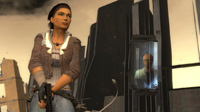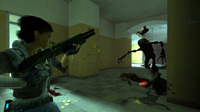Review of Episodic Content, Half-Life 2 Episode One 330
Half-Life 2 was worth the wait. Great story, beautiful graphics, and inventive gameplay made the game a worthy successor to Valve's 1998 classic. Last week gamers were finally allowed access to the next part of the story. Half-Life 2: Episode One is a fast-paced and entirely worthwhile continuation of Gordon Freeman's tale. It also raises some really good questions about the very idea of charging for small chunks of content. Read on for my review of this $20 experience, and a few comments on the episodic content debate.
- Title: Half-Life 2: Episode One
- Developer/Publisher: Valve
- System: PC
The climactic finale to Half-Life 2 (HL2) left most players with mixed emotions. Elation at the completion of a fantastic shooter, and frustration at the sudden ending to the game's engaging story. Episode One picks up immediately after HL2 leaves off, and quickly reacquaints you with Alyx Vance and her robotic comrade. Within minutes, you're back in the thick of things, hard at work playing liberator to the human race. Episode One's story centers on the escape from City 17, the aftermath of the events of the original game, and the relationships between the resistance movement members. There are a few answers, some disappointing cop-outs, and a lot of new questions raised. The fate of Doctor Mossman, in particular, is a nagging question; her exploits are a briefly mentioned plot thread that is never readdressed or resolved. Like HL2 proper, the end of the episode is a major cliffhanger. If I had as many 'fade to white' moments in my life as Gordon has, I'd be awfully confused. These are hallmarks of Valve's storytelling at this point, though, and I don't begrudge them the need to keep us begging for more.
In fact, in almost every way possible Episode One is a success for Valve. This game is the first in a trilogy planned to end next year, and Valve has done a fantastic job in capturing interest with this initial effort. Unlike SiN Episodes , which amused but failed to engage, Episode One was so gripping I almost immediately restarted the game with 'commentary mode' enabled just to see if I could glean any more from a second go-round.
As entertaining as the story is, this title truly shines in its gameplay. Creating Half-Life 2's gameplay was a long process of trial and error. For the player, a degree of handholding was required to teach the skill required to play. Episode One, in contrast, relies on your knowledge of FPS controls and experience with the original title, packing the relatively short game with eyebrow-popping moments. New uses for the gravity gun, clever physics puzzles, the near-constant presence of Alyx Vance, and some very challenging gunplay all add to the title's brisk pace. Of particular note are the moments where Valve tweaks the player expectations. A quick crawl through the ducts becomes a drawn-out odyssey through heavily trapped rooms; you know you're having fun when death provokes a laugh instead of a sigh of frustration.
While I certainly wouldn't classify HL2 as 'easy' on normal mode, the difficulty of firefights in Episode One takes things up a notch or two from combat in that game. Several action set pieces move beyond the more straightforward boss battles; they pit you and Alyx against waves of different enemies, or put you in close quarters with some vastly unpleasant creatures. The addition of a new zombie (the 'zombine') and smarter combine soldiers contributes to this challenge. The zombine in particular (a headcrab-infested combine soldier) is a tough opponent. It takes quite a few more hits than the normal zombie to dispatch. It also displays limited tactical ability, waiting for a small knot of its kind to form before rushing you, or using a grenade to act as a walking bomb. The smarter human footsoldiers are often a frustrating surprise; they take cover and shoot straighter than their cousins in the original game.
Episode One looks great, of course. Some additional shiny has been added to the title, but for the most part you're going to be seeing the same textures and environments as in HL2 proper. It would have been nice to see some dramatically new areas, but the urban jungle you traverse on your way out of the city is as engaging as it is familiar. Sound effects are also reused, but the musical stings to accompany important moments are new and seemed more carefully composed than some of the previous offerings.
In a nutshell, Episode One is Half-Life 2 all over again. Perhaps because of its short duration (only about five hours or so), it actually manages to be even better than the original title in almost every way. The puzzles are inventive, the combat is more intense, and the story grabs you within minutes of game start; the moment, early on, where Dog and Alyx have a great moment of simple character interaction made the price of entry well worth it (for me). I've played a lot of games since Half-Life 2 came out, but this is still a franchise that impresses; Valve delivers on everything it promises. If you like story with your shooter, play this game.
The fact that Valve has released a great product should come as no surprise. What strikes me most about this title is its place in a larger debate. Episodic content has provoked a number of earnest conversations this year; how much to charge, how much content is enough, and how often content is released all seem to be sticking points in the gaming community. When Bethesda began releasing commercial mods for Oblivion earlier this year, there were a number of people that felt three dollars for horse armor was a tad much. Subsequent releases for that game have been weightier, and their low price (just $1.98 for a pirate ship) seems to have allayed criticism of those offerings.
In comparison, last month's SiN Episodes was 5-6 hours of gaming for twenty bucks. About it, I wrote "If Emergence was $15, this would be a sure thing; at $20 I'm not sure this particular ride is worth the price of admission." Now that I've seen what my $20 can get me, I know it's not worth the price of admission. If we can expect Valve's success is a high-water mark for episodic content there's going to have to be a serious reexamination of pricing and release for future, lesser offerings. I'm willing to wait for Episode Two at this point; as far as I'm concerned Valve already has my money. At the same time, I'm unlikely to purchase the next episode of SiN. The story just didn't grab me, but the amount of time we're going to be waiting is what really frustrates. With no word yet on a release for the next episode in SiN's season, we're looking at a three months wait (or more) for another length of lackluster writing and time-worn gameplay.
Valve has proven they can deliver, and four dollars an hour should be a premium price for their premium product. In contrast, SiN is just not worth it. I want faster, cheaper, or more. Two of those three will make the next developer to try for the episodic market a success. Perhaps a SiN-quality game that lasts eleven hours for $15? Or the same length for $10 every other month? I would even be interested in true micro-installments. Two or three hours of content for five bucks every month would be a good standard to set. At that rate, the television season comparison SiN is reaching for becomes a reality.
What I enjoy most about the concept of episodic content is the potential. Can developer schedules achieve a brisk enough turnaround? Will enough gamers purchase the second episodes of SiN and Half-Life 2 to ensure there will be a third? With the popularity of Xbox Live, will more developers jump on the episodic bandwagon? I, for one, certainly hope so.






So.... uhh.... /shifts eyes (Score:3, Funny)
Re:So.... uhh.... /shifts eyes (Score:5, Funny)
I wish I had more time to play it... (Score:2, Funny)
well (Score:2, Funny)
You've got to admit that even 5 hours is more entertainment value than that other thing called "episode one" offered.
Progress?
Re:Download problems? (Score:3, Funny)
Re:Put it in context (Score:1, Funny)
Seek out the 'stone of washing under the arms', this artefact can help a lot in the next stage.
Completely outside of the game this one, get to know the creatures that are called 'the women folk'; converse with them, they are kind and helpful!
Find a way to avoid the 'waste your life [in a crappy fantasy] spell'; the mantra "not another fucking elf!" can be useful here
Hopefully this will lead you to the fabled 'sword of growing up', found in the temple of 'be who you want to be in the real world and not a blatant sucker.'